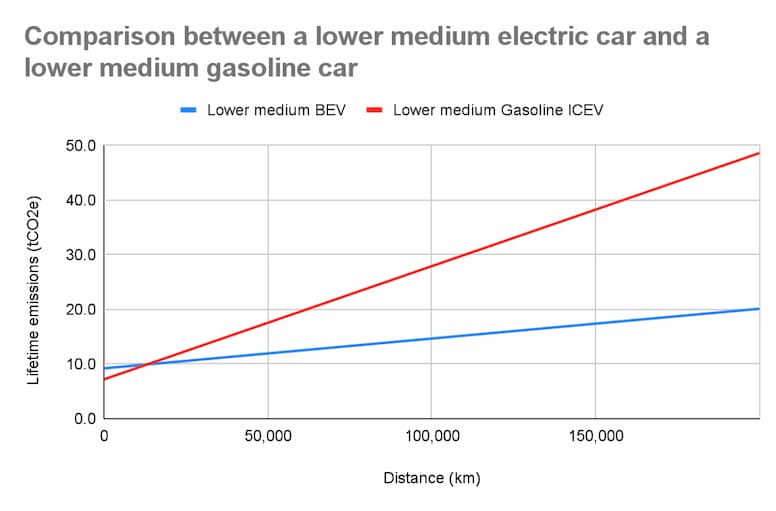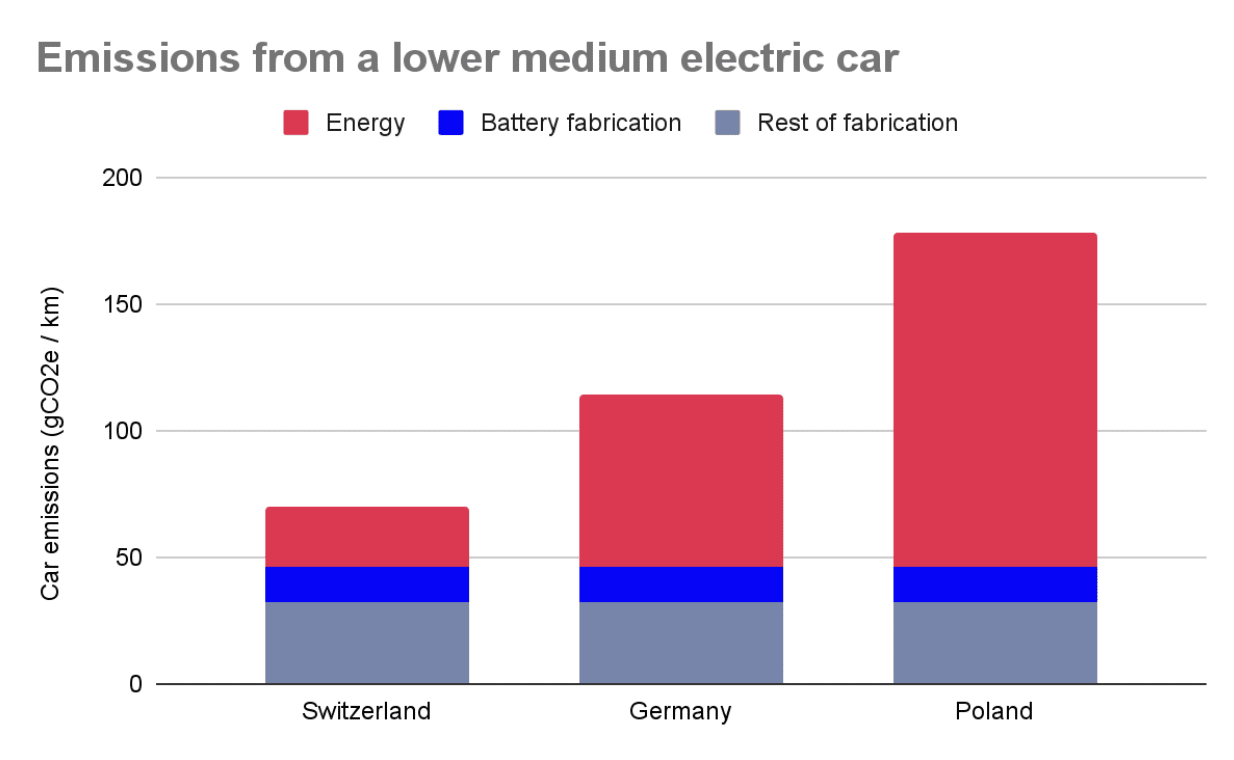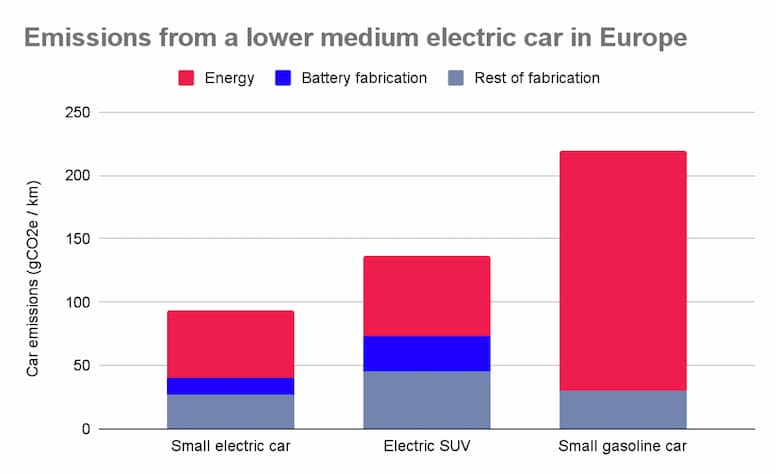The automotive sector has a crucial role to play in advancing the transition to a low carbon economy. Indeed, with greenhouse gas (GHG) emissions estimated to be 4 Gt of CO2e (CO2 equivalent) per year, this industry represents 8% of global anthropogenic emissions. The market is starting to react, as well: in Europe, sales of electric vehicles represented 3% of sales in 2019, but 17% in 2021.
Besides that, and as part of their transition to a low-carbon economy, an increasing number of governments and institutions are going all-in on electric cars, too. In June 2022, the European Union announced that sales of combustion engine vehicles will be banned by 2035. California passed a similar measure two months later.
That being said, some concerns have been raised about the actual effectiveness of this measure, based on the following interrogations.
How emissive is the production of electric batteries?
How useful is it to get an electric car, if the electricity is generated thanks to energy sources such as coal or natural gas?
These questions raise valid points, which must however be balanced with the drawbacks of current internal combustion engines. Ultimately, it all comes down to this question: in which cases are electric cars less emissive than a similar internal combustion car?
This article aims at helping you understand better the pros and cons of going electric, from the perspective of carbon emissions. N.B.: this article only considers issues related to carbon. We don’t consider systemic considerations regarding social, economic, or more comprehensive environmental questions. Unless specified otherwise, all data comes from the International Council on Clean Transportation (ICCT).
Which steps should be taken into account in the comparison? Are electric cars zero-emissions vehicles? Of course not. This allegation is sometimes made in advertisements from car manufacturers, and it mixes up two very different things: zero tailpipe emissions, and zero emissions in the car’s entire life cycle.
This means that to make a fair comparison between electric cars and internal combustion vehicles, it is necessary to take into account all the emissions that occur during the lifecycle of the vehicles.
For this reason, the following items shall be included in the study:
The fabrication of the car, excluding the electric battery,
The fabrication of the electric battery,
The energy used to run the car – is also known as well-to-wheel emissions.
1/Electric cars emit more during the fabrication phase but catch up during the use phase
Because of its battery, building an electric car is significantly more emissive than building an internal combustion car. Indeed, the fabrication of a battery involves extracting and transforming lithium and other heavy metals, which is very energy-intensive.
All in all, for cars that are sold in Europe, it is estimated that each kWh of battery emits 60 kilograms of CO2e. In other words, for a car with a capacity of 45 kWh, the manufacturing of the battery alone will generate 2.7 tons of CO2e. However, because of the higher efficiency of their engine, electric cars more than compensate for this handicap during the use phase.
To illustrate this point, here is a comparison between the CO2e emissions of an average electric car in Europe and an internal combustion car.

In Europe, a lower medium electric car is break-even with an equivalent gasoline car after 13,000 km, which is usually less than a year of use. Besides that, during its lifetime, it will emit around two-thirds less carbon dioxide than its gasoline counterpart.
2/The emission of an electric car is strongly dependent on the country
The CO2 emissions of an electric car is highly dependent on the country where it is used, because of varying approaches to electricity generation. To give a few examples:
In Switzerland, the electricity is mainly generated by hydro and nuclear plants, so its generation is particularly carbon-free,
On the other hand, in Poland, the generation of electricity is highly dependent on coal, which makes it a lot more carbon-intensive.
This means that during the use phase, driving an electric car in Poland will generate six times more greenhouse gases than in Switzerland – assuming a lifetime mileage of 200,000 kilometers.

Note : the graph assumes that the carbon intensity of electricity does not evolve during the car’s lifetime. In practice, it is likely to decrease in the future: in Europe, the CO2e emissions from the generation of a kilowatt-hour of electricity have been reduced by 20% between 2010 and 2020.
That being said, if you live in Poland, an electric car is still less emissive than a gasoline car. On average, a gasoline car will generate 243 grams of CO2e per kilometer, which is 35% higher than an electric car in Poland.
3/Be careful about the size of your car
In terms of CO2 emissions, larger electric cars have two disadvantages when compared to smaller ones:
The bigger the car, the more energy it needs to drive the same distance,
In order to keep a similar level of autonomy, larger cars will also need bigger batteries, which drive up emissions.
To give an example, here is a comparison between the lifetime emissions of a small electric car and an electric SUV in Europe. The SUV is assumed to weigh around 2 tons and to have a battery capacity of 95 kWh.

Because of its larger battery and energy consumption, the electric SUV will generate almost 50% more CO2 during its lifetime than a small electric car. Ultimately, switching to electric cars is not the answer to everything: in order to manage the transition successfully, we will also need to reduce our energy consumption, which implies smaller vehicles.
Conclusion
Despite the emissions from the battery’s fabrication, and even in countries where the electricity is intensive in CO2, electric cars are less emissive than their gasoline counterparts.
Because the demand for electric cars is growing very rapidly, and because of impending restrictions for sales of internal combustion engines, the next few years will be decisive for car manufacturers. If you want to know more about this and learn which manufacturers are at the forefront of the transition to electric cars, you may check our two more detailed articles on this topic. Automakers carbon performance ranking – Part 1 and Automakers carbon performance ranking – Part 2
If you enjoyed our approach to this topic, fact-based and considering all three scopes of emissions, do not hesitate to reach out to us. We can help you assess your carbon footprint.
